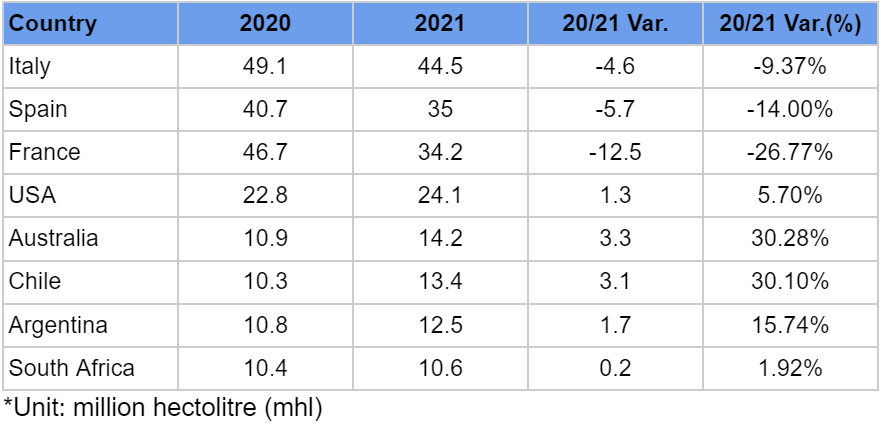Overview of Global Wine Production 2021

Decrease of 10 Million Hectolitres of Wine in 2021
Global wine production in 2021 is estimated between 247.1 and 253.5 mhl, with a mid-range estimate of 250.3 mhl. This number is very close to the 2017 harvest of 247 mhl, which was the smallest volume produced in 60 years, according to the International Organisation of Vine and Wine (OIV). The 2021 production signals a 4% drop compared to the already small 2020 harvest of 260 mhl and comes in at 7% below the 20-year average of 269 mhl. In other words, the 2021 harvest marked a decrease equivalent to 1.3 billion bottles of wine compared to the 2020 harvest. The 2021 harvest can therefore be considered extremely low and marks the third consecutive year of below-average global wine production.
Major Wine Producers in the Northern Hemisphere
The global wine industry’s production can be divided into two geographic regions with distinct growing seasons. The Northern hemisphere produces wine grapes from late August until the end of October while the Southern hemisphere produces grapes from late January until the end of March. The four dominant wine-producing countries located in the Northern hemisphere are Italy, Spain, France and the US, which were responsible for 55.1% of global wine production in 2021. Unfortunately, Italy, Spain, and France experienced severe spring frost, which resulted in a combined loss of 22 mhl compared to 2020.
Italy remains the largest wine producer in the world in 2021 with 44.5 mhl, a 9% drop compared to 2020 and its five-year average. Spain is the second-largest wine producer in the world in 2021 at 35.0 mhl, 14% lower than 2020 and 9% lower than its five-year average. France experienced the most severe climatic conditions in 2021, with severe frost in April, followed by summer rain, hailstorms, and powdery mildew. As a result, France lost its title as the second largest producer to Spain with a production level of 34.2 mhl, representing a 27% drop compared to 2020. In contrast, the US produced 24.1 mhl for the 2021 season, 6% higher than the 2020 harvest, which was relatively small due to wildfires and smoke taint.

Major Wine Producers in the Southern Hemisphere
Major wine-producing countries in the Southern hemisphere reported sharp increases in 2021, with a record-high total harvest of 59 mhl, representing a 19% increase compared to 2020. The increase follows a strong decline in wine production in 2020 due to unfavourable climatic conditions.
The four largest producers in the Southern hemisphere are Australia, Chile, Argentina and South Africa, which account for 20.3% of global wine production. Australia recorded its biggest harvest since 2006, recording a production of 14.2 mhl, which is 30% higher than 2020 and 14% higher than its five-year average. The sharp increase in harvest can be attributed to favourable harvest conditions, mild temperatures, and low disease pressure in 2021 compared to the previous two production years, which were hampered by drought and wildfires.
Chile and Argentina, the two dominant South American countries regarding wine production, registered significant production increases compared to 2020. The absence of severe weather conditions usually caused by El Nino appears to have contributed to high wine production levels in 2021. Chile, the largest wine producer in South America in 2021, produced 13.4 mhl of wine, the highest level recorded in 20 years. It represented a 30% increase compared to 2020. Argentine wine production rose 16% compared to 2020 to 12.5 mhl after a very low production during the previous harvest. South Africa recorded a 2021 harvest of 10.6 mhl, indicating a 2% production increase from 2020. South Africa recorded its third year of consecutive growth following a prolonged drought which severely impacted local wine production. The high production levels from Southern hemisphere countries offset the low production levels from the Northern hemisphere countries to a certain extent. Still, they could not offset the losses experienced by European countries entirely.
Southern hemisphere wine-producing countries are currently in the midst of their harvest season. Initial indicators are that 2022 will be an average harvest for all countries except Chile, which has experienced wetter and more humid weather conditions than normal, raising disease and rot concerns in harvest time.
Outlook in 2022
The below-average harvests of the past three years have resulted in lower levels of wine supply, which was not a concern since global wine consumption was also depressed due to the pandemic. However, as the world tries to recover from the worst brunt of COVID-19 and return to a sense of normalcy, demand for wine is increasing. Consequently, it is expected to increase further, putting pressure on the limited available supply, especially in areas with recently low production volumes. This was observed during the 2021 season, with countries such as France, Italy and Spain experiencing increased trade volume, trade value, and price regarding wine in comparison with 2020. The trend is expected to continue in 2022 with higher prices, higher trade volume, and trade value in the global wine industry.


